Genre theory is an important element of the study of film art. However, individual genres are often generalized and limited (Raynor, Wall, & Kruger, 2008, p. 2), and a movie may simultaneously belong to multiple genres. The Fly is a body horror movie, but it is also a romantic drama telling a story about a scientist finding love before developing a terminal illness (Pheasant-Kelly, 2016, p. 242; Rubinson & Mueller, 2016, pp. 602-603). One of the scenes that illustrate this idea is the insect politics scene. Through the analysis of its key thematic and semiotic elements, the present paper will aim to answer the following question: how does the film explore the topic of terminal disease and its impact on the ill person and his lover?
Brief Summary: The Film and the Scene
The Fly is about a brilliant inventor Seth Brundle (Jeff Goldblum) who falls in love with a journalist Veronica Quaife (Geena Davis). Due to the inspiration he finds in Veronica, Seth manages to perfect his teleportation devices, making them capable of transporting live creatures. However, when he tries teleporting himself, a fly makes its way into his telepod, which leads to the two being fused on the genetic level. Seth starts to change in his body and mind, eventually becoming a monster that kidnaps Veronica and tries to force her and their unborn child to fuse with him. In the end, Veronica has to kill her lover.
The insect politics scene happens after Veronica learns about being pregnant. Since the impregnation could have occurred after the transformation, she plans to have an abortion, but she wants to inform Seth first. She comes to Seth’s hideout and finds him noticeably deteriorated as a result of the transformation. She does not manage to mention pregnancy because Seth starts talking about insect politics; Veronica is disturbed. Seth then steps into the light, showing his bodily deterioration, and tells Veronica about the decline in his mind. He believes himself to be cruel and incapable of compassion; he feels that he might hurt Veronica if she stays. Veronica leaves in tears, and Seth is left to wallow in his despair.
Major Themes of the Film and the Scene
Directly Stated Themes
The scene contains a direct image presented by Seth: that of insect politics. According to Seth, insect politicians do not exist because insects are cruel, which is meant to convey the idea that he has become cruel as a result of his condition. Seth’s roundabout way of explaining the issue disturbs Veronica, but based on Jeff Goldblum’s acting, Seth did not try to unsettle her. Rather, given how difficult it is for him to step into the light, he did not want to have to voice and acknowledge his concerns. While prior scenes showed that the transformation affected Seth’s mind, this one spells it out directly, depriving Seth and Veronica of the opportunity to deny it. In this scene, Seth acknowledges that he is not the man he used to be; he is Brundlefly now.
Levi-Strauss and Binary Opposites
One of the theories that have been used in narrative analyses is the Levi-Strauss’ binary opposites. Levi-Strauss noted the tendency of humans to use opposites to denote insiders and outsiders (De Valk & Arnold, 2013, p. 71). Seth’s speech brings forth two opposites: the human and the insect. Seth views the insects as the inferior group, to which he now belongs. In particular, Seth highlights the cruelty of the insect and suggests that one cannot trust it. These qualities are the opposites of those attributed by Seth to humans.
When Seth describes his condition as an insect dreaming that it is a man, he notes that the dream was pleasant; the insect loved it. However, Seth proceeds, the dream ended, and he cannot pretend to be a man anymore. The statement is meant as a threat (see Figure 1), but it also signifies that Seth decides to come to terms with his transformation. After this scene, Seth cannot pretend that he has not changed or that he does not consider the changes detrimental.
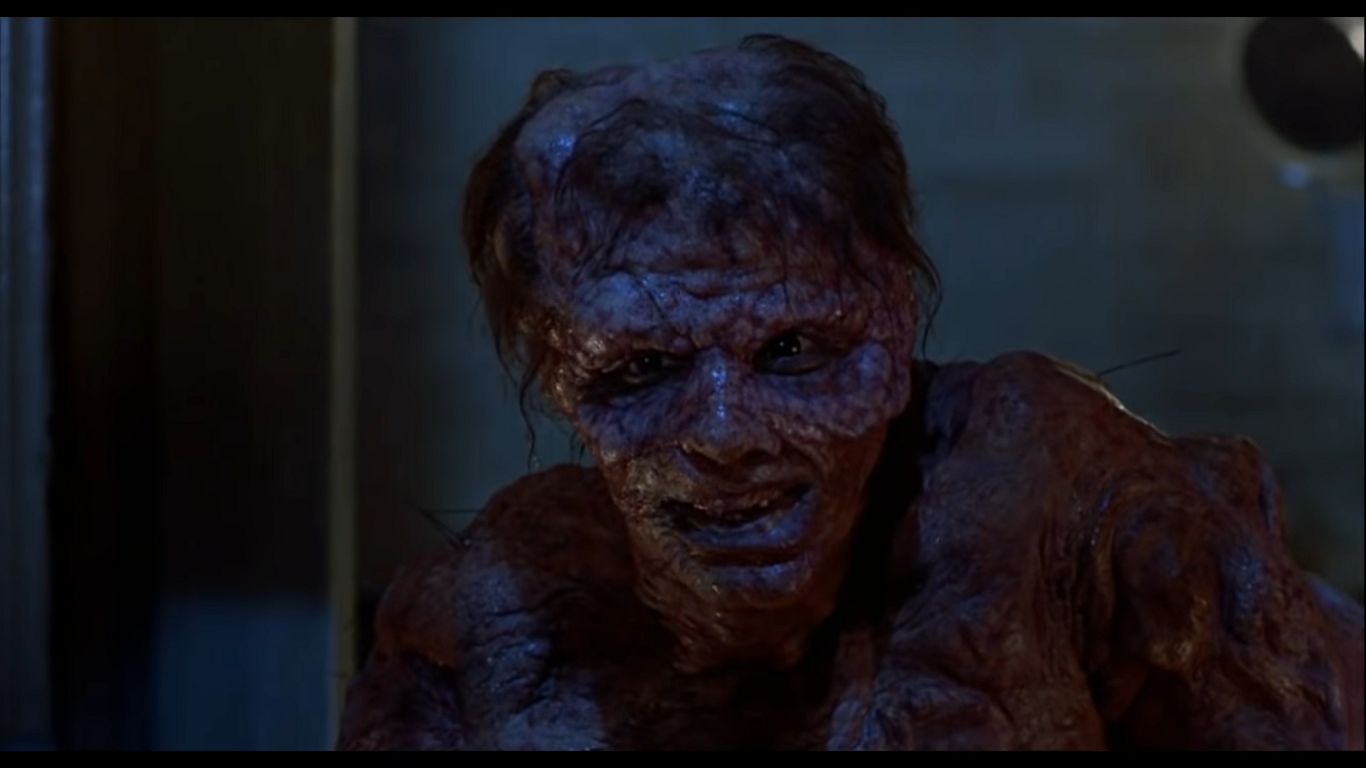
The way Seth shrinks under the light once he steps into it also highlights the idea that he believes that he has become inferior. In comparison, Veronica remains in light since the beginning of the scene. There is a plain explanation for these frames: Brundle is ashamed of his transformed body. However, the director included a shot of Brundle looking longingly up to the key source of light, which appears to indicate a feeling of falling from grace (see Figure 2).
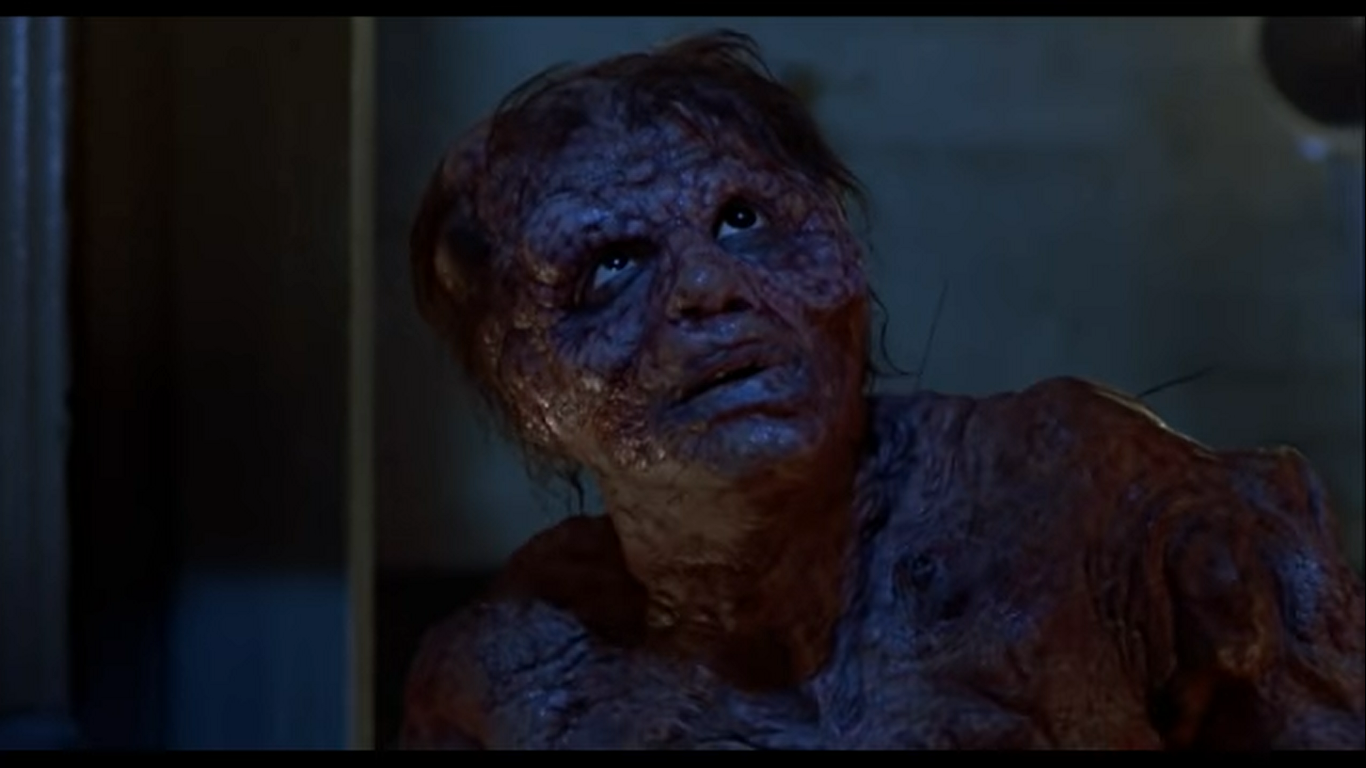
The Illness Metaphor, Ableism, and Todorov’s Narrative theory
The idea that The Fly is a commentary on terminal diseases is probably a fact. The movie makes this connection on its own: Seth mostly refers to his condition as an illness, likening it to cancer. Another candidate is AIDS due to the contamination element of Brundlefly’s story; he is “infected” with fly DNA rather than just develops a disease (Moody, 2016, p. 242). The outbreak of AIDS in the US may have helped critics to make this connection (Pheasant-Kelly, 2016, p. 242). Furthermore, Brundle’s transformation has been compared to aging by Cronenberg himself (Moody, 2016, p. 242). However, the specific condition that Brundlefly’s state can be related to is not relevant; what is important is that it causes the deterioration of not only his body but also his mind.
In the beginning, Seth is shown to be a kind, sensitive, very intelligent, and good-looking man; this part of the film coincides with what would be described by Todorov’s theory as the “equilibrium” or “harmony” (Raynor et al., 2008, p. 6). From this perspective, Seth’s contamination with fly DNA becomes the disruption of the equilibrium. Because of this disease, which can be conceptualized as an “outsider” that disrupts the equilibrium, Seth loses all his positive qualities. However, the “outsider” is not actually outside Seth; it is within him. The insect politics scene is the one where Seth acknowledges his change and its implications for himself and Veronica. In a way, this act can signify the institution of a new equilibrium, but it is not a return to a harmonious state without the outsider. The damage done to Seth cannot and will not be repaired. Deterioration and loss of health, intellect, and humanity are the primary themes of the film and the scene that are reflected in the illness allegory.
If the fly DNA contamination is conceptualized as an illness, the dichotomy of the insect and man appears derogatory. An illness does not make a person inferior, even if it affects their ability to empathize or think; this perspective is the definition of ableism. Ableism is a political problem that can be defined as the institutional oppression of disabled or ill people, but it is also a sociocultural phenomenon which gets reflected in bias, prejudice, and dehumanization aimed at ill and disabled people (Ostiguy, Peters, & Shlasko, 2016, p. 299). Seth exhibits internalized ableism, which prevents him from getting treatment. In a prior scene, he refuses to seek help to avoid becoming another “tumorous bore” who bothers others with his pain (Cornfeld & Cronenberg, 1986). In the insect politics scene, Seth’s hatred toward his diseased body becomes even more apparent.
The opposition of insect and human is introduced by Seth himself; Veronica tries to protest when he claims to be an insect. The film also resists the idea of dehumanizing Seth given the efforts aimed at humanizing him. Even during the final scenes, the audience is meant to empathize with him, although Seth has kidnapped a woman and mutilated a man by then. The feeling of being less than human is how Seth makes sense of the situation; the insect politics speech reflects Brundle’s reaction to the loss of control over his mental and emotional intellect to the “outsider” that is his disease. This scene, as well as a large portion of the film, is an exploration of the emotions of a person who suffers from an affliction that alters his mind. For Seth, the emotions include self-hatred and self-derision.
Shots, Acting, and Score
The scene consists of medium close-up shots with the camera being relatively close to the actors. They are shown “from the shoulders/chest area up to the top of the head” (Mercado, 2013, p. 41). The backgrounds are slightly blurred; the camera captures facial expressions and head, hand, and shoulder movements. As pointed out by Mercado (2013), this approach is meant to allow the audience to see the nuances of acting and facilitate empathizing with the characters (p. 41).
From the perspective of editing, the camera cuts from Seth to Veronica and back, staying on the character that is talking and showing their reactions to each other’s words (see Figures 1-8). This approach is called the “shot/reverse shot pattern” (Bordwell & Thompson, 2012, p. 236). In addition, the scene follows the 180° system, and it employs the eyeline match technique (Bordwell & Thompson, 2012, p. 236; Mercado, 2013, p. 73). Thus, both characters are shown to look at each other (see Figures 3 and 4). This way, the audience can follow the dialogue between Veronica and Seth, and the focus remains on their emotional reactions. Throughout the scene, Veronica’s face is lit; Seth’s is not at first, but his facial expressions can be discerned even in the shadows. The lighting in the scene is meant to indicate that Veronica cannot see Seth before he exposes himself (see Figure 3). It may also have indirect meanings described above.
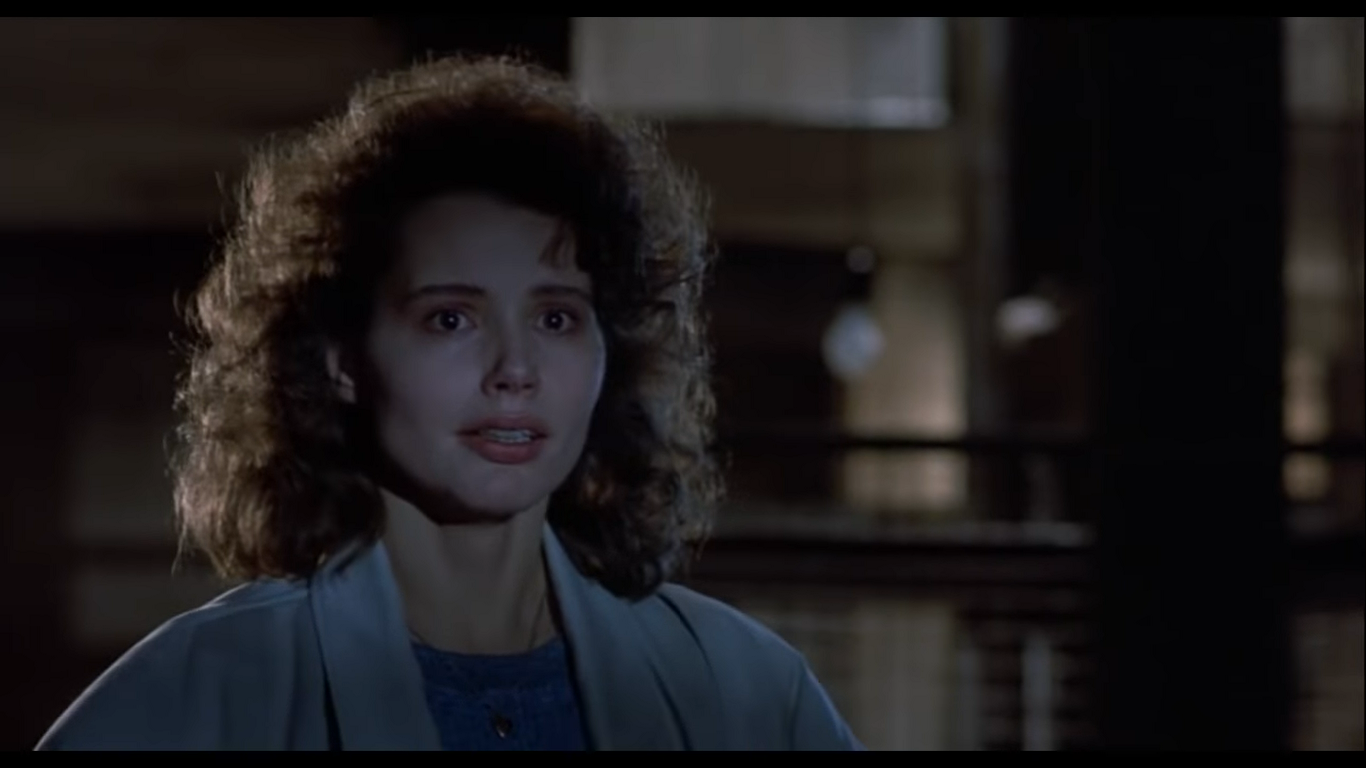
The acting of Geena Davis and Jeff Goldblum is an important element of the scene. It is especially true because of the attention that the camera pays to their performance by using medium close-ups (Mercado, 2013, p. 41). Jeff Goldblum tries to convey the changes in Seth through twitches and awkward movements; the transformation is also shown directly with the help of heavy make-up and a costume. As played by the actor, Seth tries to stick to gallows’ humor (see Figure 4), but his anguish is visible, especially when he forces himself to admit to wanting to hurt Veronica and when he hears her walk away (see Figures 5-6). In addition, Goldblum makes Seth look sinister for a few frames (see Figure 1), but mostly, the actor shows him to be in pain and despair.
Geena Davis’ emotions are also captured by the camera. She appears hopeless and painfully concerned over Seth’s seemingly nonsensical speech (see Figure 7) and horrified and hurt upon seeing his transformed body (see Figure 3). As she moves away, it looks like she lacks the strength or will to do so; she staggers rather than walks (see Figure 8). Goldblum and Davis manage to covey the love the characters hold for each other and the pain and despair they experience because of the end of their relationship.
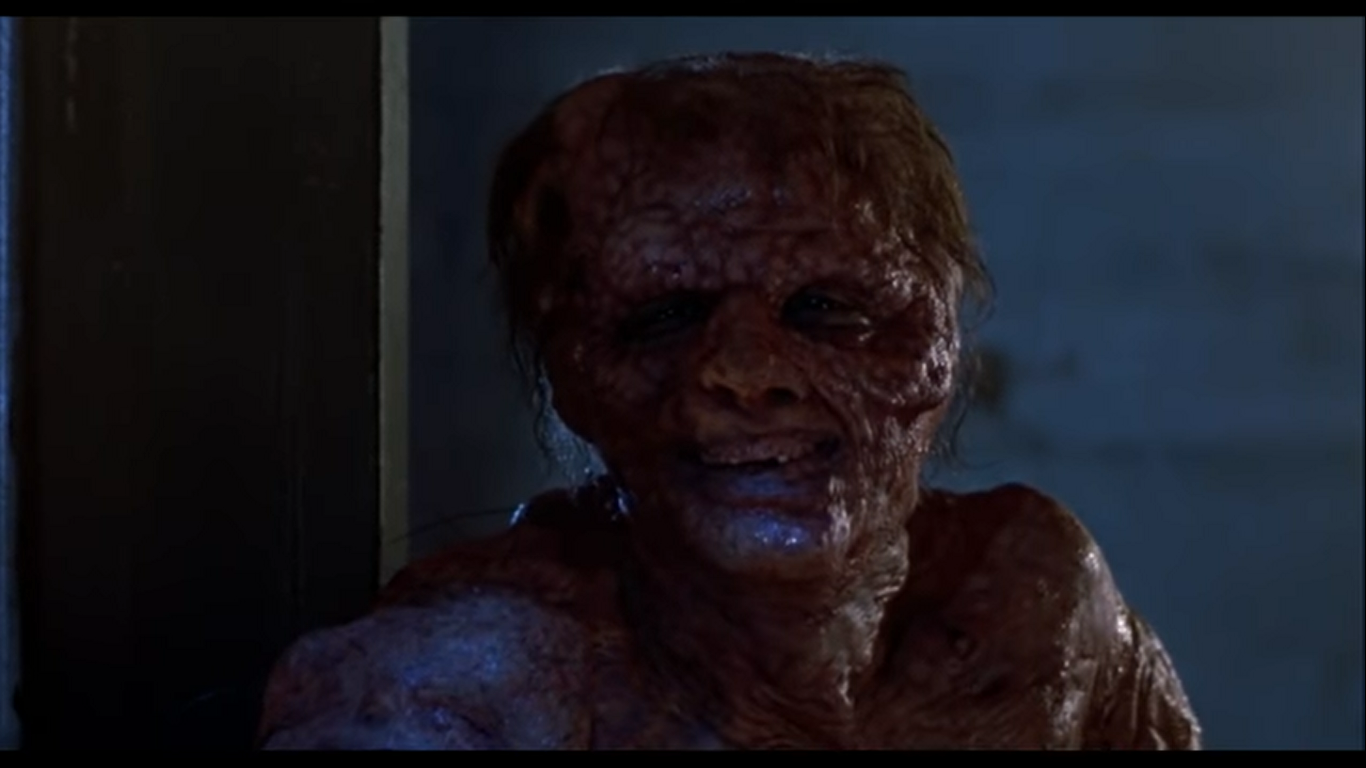
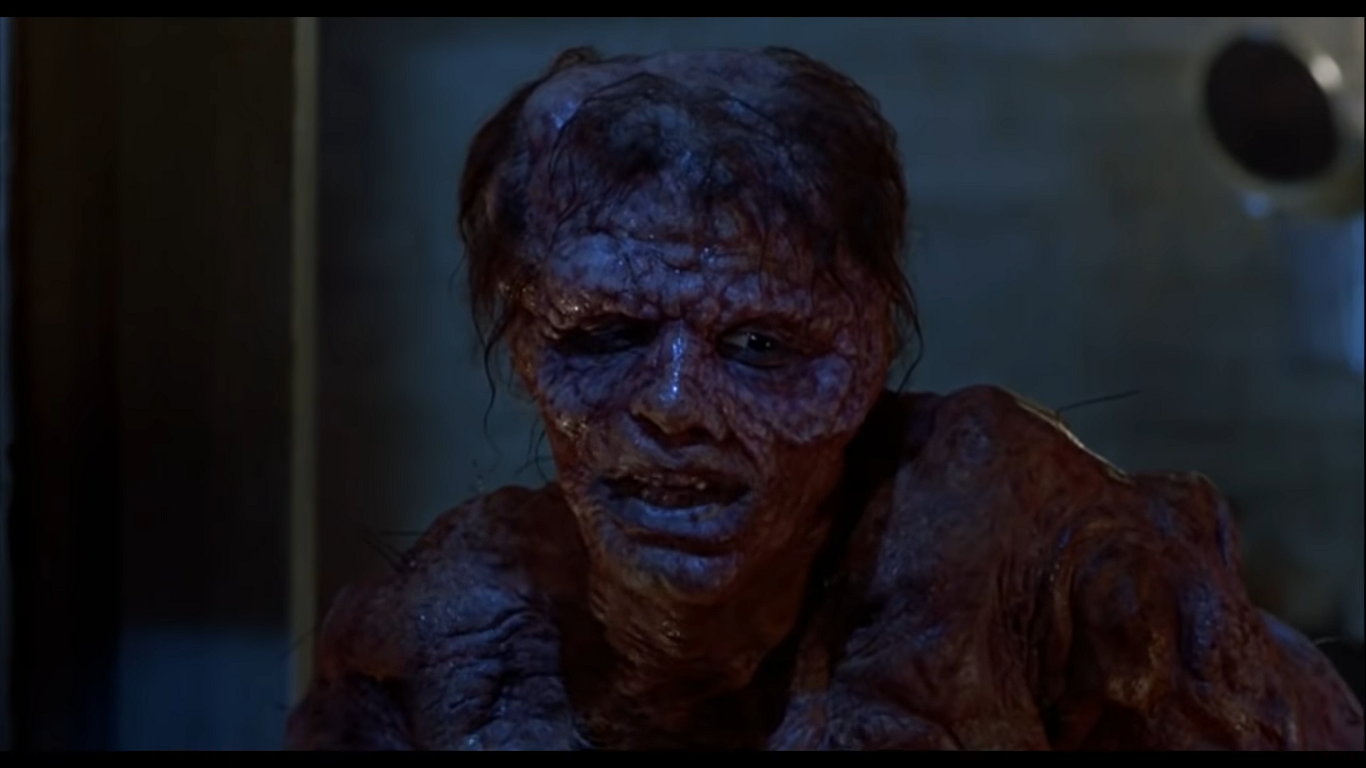
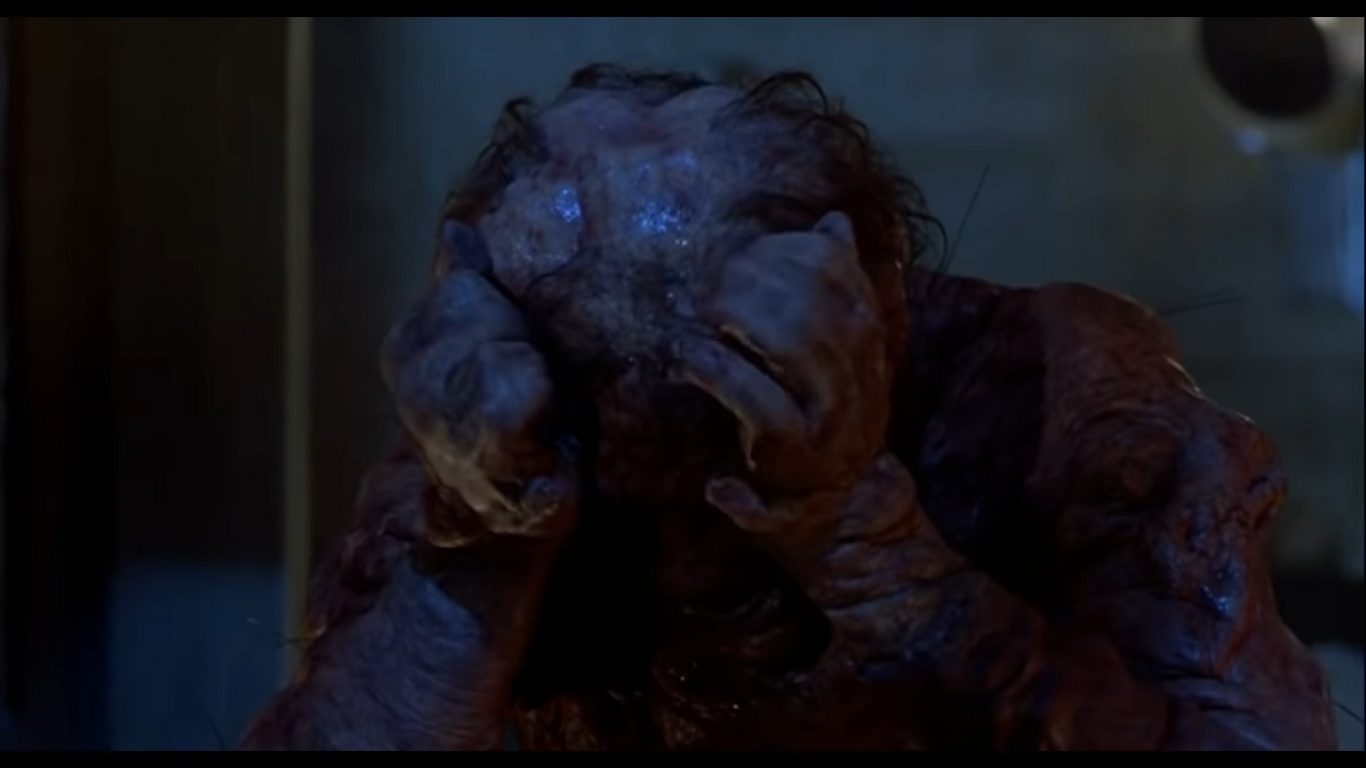
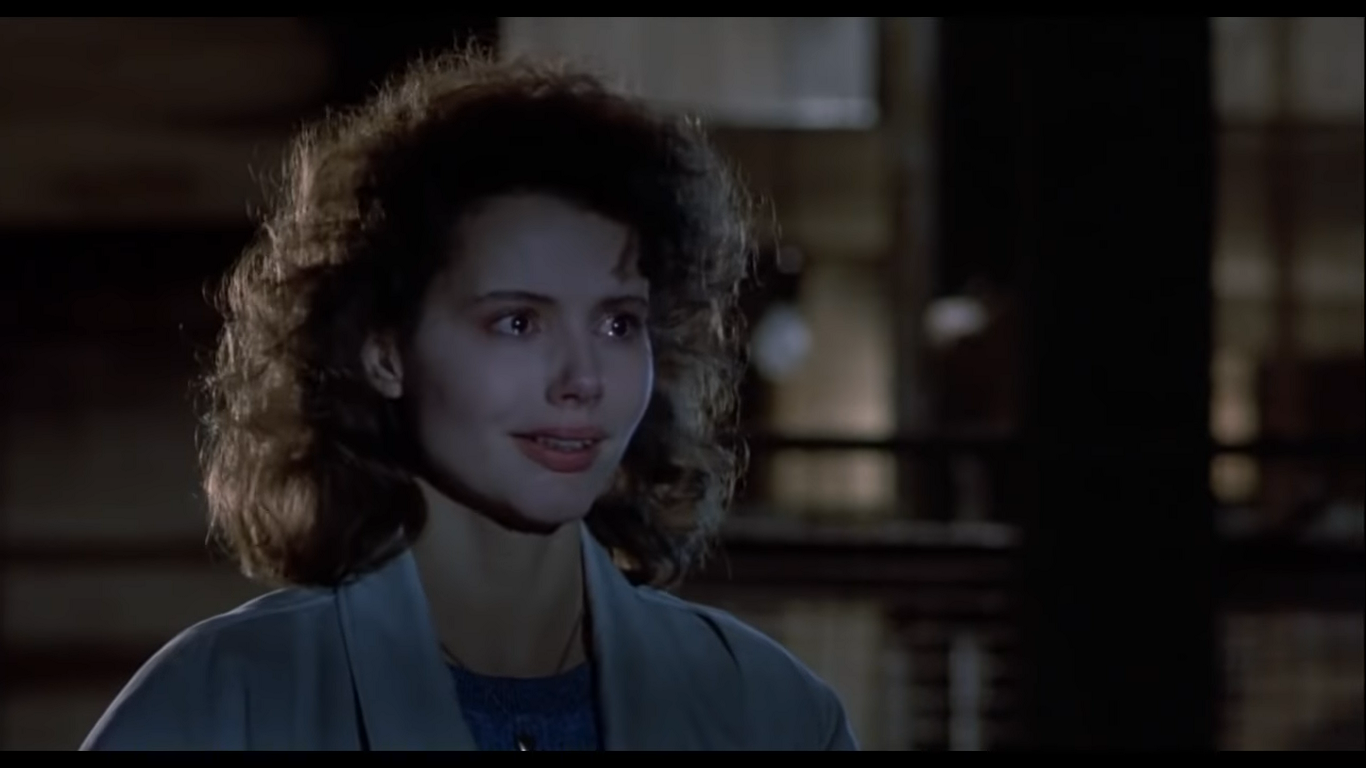
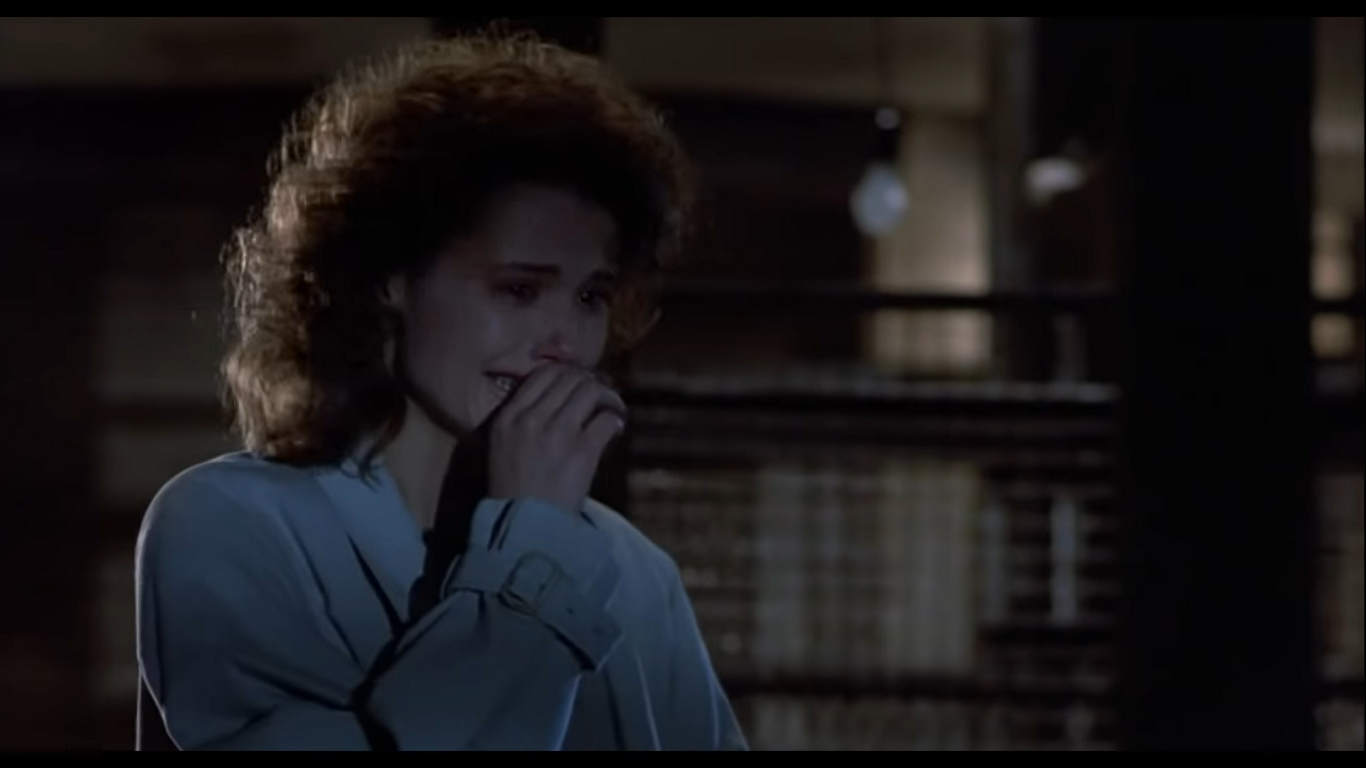
The score contributes to the mood of the scene. The sound can affect the viewers’ understanding of the events (Bordwell & Thompson, 2012, p. 267), and here, it guides the audience to recognize Brundle’s tragedy. The beginning of the scene is mostly quiet, bringing attention to Seth’s speech, but the nondiegetic music becomes louder as Brundle proceeds to make his point. It significantly increases in volume when Seth makes his comment about wanting to hurt Veronica, drawing attention to the line and its implications. The sound of Veronica slamming the door is very loud and deliberate, but the event happens off-screen; the camera stays on Seth during it to capture his despair. Thus, the score, along with the camerawork and acting, should assist the audience in empathizing with Seth despite his current looks and insistence that he is dangerous.
The Auteur Approach: Cronenberg’s Body Horror
David Cronenberg is among directors who have very distinct styles, which is why may be reasonable to apply the auteur approach to The Fly. While it is not his only technique, one of the methods that Cronenberg is famous for is body horror (Benson-Allott, 2017, pp. 152-154). Cronenberg does not use it just for its shock value, though: instead of exploiting human fear, he explores it and the reasons for it, including illness (Moody, 2016, p. 242; Pheasant-Kelly, 2016, p. 242). In The Fly, the body horror in it is very prominent, starting with small enigma codes meant to hint at Seth’s condition (the strange hairs growing from his back at the beginning of the transformation) and ending with Brundle’s final forms that barely look human. However, these special effects do not exist for their own sake. The attention is focused on the feelings that are experienced by Veronica and Seth as a result of the transformation. This way, the film provokes a reaction to a diseased and contaminated body, which is unlikely to be limited to disgust when the audience empathizes with the person who experiences the disease.
The ending of the insect politics scene illustrates this observation. When left alone, Seth brings his hands to his head, demonstrating their deformities, including withered little fingers; the viewer has not seen them in a close shot before (see Figure 6). However, Seth is in great emotional pain, and Goldblum makes sure to covey it; the score assists him. The combination of acting and music make the body horror in this instance more likely to instill pity than fear, inviting the audience to empathize with the horror-movie monster and acknowledge his pain.
Conclusion
The investigation of Cronenberg’s methods is relevant for expanding one’s understanding of film craft. The presented Levi-Strauss- and Todorov-based analyses of the themes of the insect politics scene, as well as the consideration of the key techniques and the director’s style, can help to comprehend the way the movie constructs its meaning. The shots, editing, lighting, score, and acting pin the audience’s attention to the emotions of the main characters and their tragic romance. The opposition of insect and man is used to comment on the emotional state of Seth and his reaction to losing control over his mind to the “outsider” DNA that contaminated his body, disrupting his life. It can be interpreted as the commentary of a person experiencing internalized ableism; the same negative attitudes towards himself and ill people prevent Seth from trying to get help.
The body horror elements of the film might be an important plot point for the director and the audience of The Fly. However, The Fly is not just a horror movie, and the Insects Politics scene proves this point. The Fly is a drama that explores the story of a man who found love before developing a deadly disease that affected both his body and mind. The suffering of the main characters is at the forefront of the story, in which the man struggles with a debilitating illness as the woman is forced to watch his health deteriorate. From this perspective, body horror is another tool that the director uses to explore the topic of a deadly health condition and its impact on the emotional and mental state of the person who is ill and his loved one.
References
Benson-Allott, C. (2017). The minor Cronenberg. New Review of Film and Television Studies, 15(2), 152-161. Web.
Bordwell, D., & Thompson, C. (2012). Film art: An introduction. London, UK: McGraw-Hill Education.
Cornfeld, S. (Producer), & Cronenberg, D. (Director). (1986). The fly [Motion picture]. United States: 20th Century Fox.
De Valk, M., & Arnold, S. (2013). The film handbook. London, UK: Routledge.
Mercado, G. (2013). The filmmaker’s eye. London, UK: Focal Press.
Moody, P. (2016). Cronenberg’s debt to Kafka: An analysis of A Country Doctor (1917) and Videodrome (1983). Journal of Adaptation in Film & Performance, 9(3), 239-251. Web.
Ostiguy, B. J., Peters, M. L., & Shlasko, D. (2016). Ableism. In M. Adams & L. A. Bell (Eds.), Teaching for diversity and social justice (pp. 299-338). New York, NY: Routledge.
Pheasant-Kelly, F. (2016). Towards a structure of feeling: Abjection and allegories of disease in science fiction ‘mutation’ films. Medical Humanities, 42(4), 238-245. Web.
Raynor, P., Wall, P., & Kruger, S. (2008). Media studies: The essential introduction. London, UK: Routledge
Rubinson, C., & Mueller, J. (2016). Whatever happened to drama? A configurational–comparative analysis of genre trajectory in American cinema, 1946–2013. The Sociological Quarterly, 57(4), 597-627. Web.